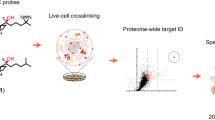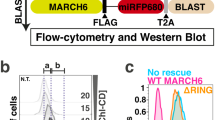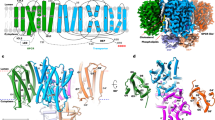Abstract
The internal organization of eukaryotic cells into functionally specialized, membrane-delimited organelles of unique composition implies a need for active, regulated lipid transport. Phosphatidylserine (PS), for example, is synthesized in the endoplasmic reticulum and then preferentially associates—through mechanisms not fully elucidated—with the inner leaflet of the plasma membrane1,2,3. Lipids can travel via transport vesicles. Alternatively, several protein families known as lipid-transfer proteins (LTPs) can extract a variety of specific lipids from biological membranes and transport them, within a hydrophobic pocket, through aqueous phases4,5,6,7. Here we report the development of an integrated approach that combines protein fractionation and lipidomics to characterize the LTP–lipid complexes formed in vivo. We applied the procedure to 13 LTPs in the yeast Saccharomyces cerevisiae: the six Sec14 homology (Sfh) proteins and the seven oxysterol-binding homology (Osh) proteins. We found that Osh6 and Osh7 have an unexpected specificity for PS. In vivo, they participate in PS homeostasis and the transport of this lipid to the plasma membrane. The structure of Osh6 bound to PS reveals unique features that are conserved among other metazoan oxysterol-binding proteins (OSBPs) and are required for PS recognition. Our findings represent the first direct evidence, to our knowledge, for the non-vesicular transfer of PS from its site of biosynthesis (the endoplasmic reticulum) to its site of biological activity (the plasma membrane). We describe a new subfamily of OSBPs, including human ORP5 and ORP10, that transfer PS and propose new mechanisms of action for a protein family that is involved in several human pathologies such as cancer, dyslipidaemia and metabolic syndrome.
This is a preview of subscription content, access via your institution
Access options
Subscribe to this journal
Receive 51 print issues and online access
$199.00 per year
only $3.90 per issue
Buy this article
- Purchase on SpringerLink
- Instant access to full article PDF
Prices may be subject to local taxes which are calculated during checkout




Similar content being viewed by others
Accession codes
References
Yeung, T. et al. Membrane phosphatidylserine regulates surface charge and protein localization. Science 319, 210–213 (2008)
Leventis, P. A. & Grinstein, S. The distribution and function of phosphatidylserine in cellular membranes. Annu Rev Biophys 39, 407–427 (2010)
Fairn, G. D., Hermansson, M., Somerharju, P. & Grinstein, S. Phosphatidylserine is polarized and required for proper Cdc42 localization and for development of cell polarity. Nature Cell Biol. 13, 1424–1430 (2011)
D’Angelo, G., Vicinanza, M. & De Matteis, M. A. Lipid-transfer proteins in biosynthetic pathways. Curr. Opin. Cell Biol. 20, 360–370 (2008)
Lev, S. Non-vesicular lipid transport by lipid-transfer proteins and beyond. Nature Rev. Mol. Cell Biol. 11, 739–750 (2010)
Holthuis, J. C. & Levine, T. P. Lipid traffic: floppy drives and a superhighway. Nature Rev. Mol. Cell Biol. 6, 209–220 (2005)
Stefan, C. J. et al. Osh proteins regulate phosphoinositide metabolism at ER-plasma membrane contact sites. Cell 144, 389–401 (2011)
Gavin, A. C. et al. Proteome survey reveals modularity of the yeast cell machinery. Nature 440, 631–636 (2006)
Gavin, A. C. et al. Functional organization of the yeast proteome by systematic analysis of protein complexes. Nature 415, 141–147 (2002)
Raychaudhuri, S., Im, Y. J., Hurley, J. H. & Prinz, W. A. Nonvesicular sterol movement from plasma membrane to ER requires oxysterol-binding protein-related proteins and phosphoinositides. J. Cell Biol. 173, 107–119 (2006)
Li, X. et al. Identification of a novel family of nonclassic yeast phosphatidylinositol transfer proteins whose function modulates phospholipase D activity and Sec14p-independent cell growth. Mol. Biol. Cell 11, 1989–2005 (2000)
Schulz, T. A. et al. Lipid-regulated sterol transfer between closely apposed membranes by oxysterol-binding protein homologues. J. Cell Biol. 187, 889–903 (2009)
Li, X. et al. Analysis of oxysterol binding protein homologue Kes1p function in regulation of Sec14p-dependent protein transport from the yeast Golgi complex. J. Cell Biol. 157, 63–78 (2002)
Ejsing, C. S. et al. Global analysis of the yeast lipidome by quantitative shotgun mass spectrometry. Proc. Natl Acad. Sci. USA 106, 2136–2141 (2009)
Slaughter, B. D. et al. Non-uniform membrane diffusion enables steady-state cell polarization via vesicular trafficking. Nature Commun. 4, 1380 (2013)
Riekhof, W. R. et al. Lysophosphatidylcholine metabolism in Saccharomyces cerevisiae: the role of P-type ATPases in transport and a broad specificity acyltransferase in acylation. J. Biol. Chem. 282, 36853–36861 (2007)
Spira, F. et al. Patchwork organization of the yeast plasma membrane into numerous coexisting domains. Nature Cell Biol. 14, 640–648 (2012)
Im, Y. J., Raychaudhuri, S., Prinz, W. A. & Hurley, J. H. Structural mechanism for sterol sensing and transport by OSBP-related proteins. Nature 437, 154–158 (2005)
de Saint-Jean, M. et al. Osh4p exchanges sterols for phosphatidylinositol 4-phosphate between lipid bilayers. J. Cell Biol. 195, 965–978 (2011)
Punta, M. et al. The Pfam protein families database. Nucleic Acids Res. 40, D290–D301 (2012)
Ngo, M. H., Colbourne, T. R. & Ridgway, N. D. Functional implications of sterol transport by the oxysterol-binding protein gene family. Biochem. J. 429, 13–24 (2010)
Burgett, A. W. et al. Natural products reveal cancer cell dependence on oxysterol-binding proteins. Nature Chem. Biol. 7, 639–647 (2011)
Beh, C. T., Cool, L., Phillips, J. & Rine, J. Overlapping functions of the yeast oxysterol-binding protein homologues. Genetics 157, 1117–1140 (2001)
Fairn, G. D. et al. High-resolution mapping reveals topologically distinct cellular pools of phosphatidylserine. J. Cell Biol. 194, 257–275 (2011)
Pichler, H. et al. A subfraction of the yeast endoplasmic reticulum associates with the plasma membrane and has a high capacity to synthesize lipids. Eur. J. Biochem. 268, 2351–2361 (2001)
Yu, J. W. & Lemmon, M. A. All phox homology (PX) domains from Saccharomyces cerevisiae specifically recognize phosphatidylinositol 3-phosphate. J. Biol. Chem. 276, 44179–44184 (2001)
Yu, J. W. et al. Genome-wide analysis of membrane targeting by S. cerevisiae pleckstrin homology domains. Mol. Cell 13, 677–688 (2004)
Park, W. S. et al. Comprehensive identification of PIP3-regulated PH domains from C. elegans to H. sapiens by model prediction and live imaging. Mol. Cell 30, 381–392 (2008)
Gallego, O. et al. A systematic screen for protein–lipid interactions in Saccharomyces cerevisiae. Mol. Syst. Biol. 6, 430 (2010)
Li, X., Gianoulis, T. A., Yip, K. Y., Gerstein, M. & Snyder, M. Extensive in vivo metabolite-protein interactions revealed by large-scale systematic analyses. Cell 143, 639–650 (2010)
Weerheim, A. M., Kolb, A. M., Sturk, A. & Nieuwland, R. Phospholipid composition of cell-derived microparticles determined by one-dimensional high-performance thin-layer chromatography. Anal. Biochem. 302, 191–198 (2002)
Churchward, M. A., Brandman, D. M., Rogasevskaia, T. & Coorssen, J. R. Copper (II) sulfate charring for high sensitivity on-plate fluorescent detection of lipids and sterols: quantitative analyses of the composition of functional secretory vesicles. J. Chem. Biol. 1, 79–87 (2008)
Tong, A. H. & Boone, C. in Yeast Gene Analysis, Methods in Microbiology 2nd edn, Vol. 36 (eds Stansfield, I. and Stark, M. ) 369–386; 706–707 (Elsevier, 2007)
Janke, C. et al. A versatile toolbox for PCR-based tagging of yeast genes: new fluorescent proteins, more markers and promoter substitution cassettes. Yeast 21, 947–962 (2004)
Chen, J., Zheng, X. F., Brown, E. J. & Schreiber, S. L. Identification of an 11-kDa FKBP12-rapamycin-binding domain within the 289-kDa FKBP12-rapamycin-associated protein and characterization of a critical serine residue. Proc. Natl Acad. Sci. USA 92, 4947–4951 (1995)
Rossanese, O. W. et al. A role for actin, Cdc1p, and Myo2p in the inheritance of late Golgi elements in Saccharomyces cerevisiae. J. Cell Biol. 153, 47–62 (2001)
Stefan, C. J., Audhya, A. & Emr, S. D. The yeast synaptojanin-like proteins control the cellular distribution of phosphatidylinositol (4,5)-bisphosphate. Mol. Biol. Cell 13, 542–557 (2002)
Fischl, A. S. & Carman, G. M. Phosphatidylinositol biosynthesis in Saccharomyces cerevisiae: purification and properties of microsome-associated phosphatidylinositol synthase. J. Bacteriol. 154, 304–311 (1983)
Panaretou, B. & Piper, P. Isolation of yeast plasma membranes. Methods Mol. Biol. 313, 27–32 (2006)
Huh, W. K. et al. Global analysis of protein localization in budding yeast. Nature 425, 686–691 (2003)
Waterhouse, A. M., Procter, J. B., Martin, D. M., Clamp, M. & Barton, G. J. Jalview Version 2–a multiple sequence alignment editor and analysis workbench. Bioinformatics 25, 1189–1191 (2009)
Felsenstein, J. PHYLIP (Phylogeny Inference Package) version 3.5c. Distributed by the author. Department of Genetics, University of Washington, Seattle, Washington, USA. (1993)
Letunic, I. & Bork, P. Interactive Tree Of Life (iTOL): an online tool for phylogenetic tree display and annotation. Bioinformatics 23, 127–128 (2007)
Crooks, G. E., Hon, G., Chandonia, J. M. & Brenner, S. E. WebLogo: a sequence logo generator. Genome Res. 14, 1188–1190 (2004)
Di Tommaso, P. et al. T-Coffee: a web server for the multiple sequence alignment of protein and RNA sequences using structural information and homology extension. Nucleic Acids Res. 39, W13–W17 (2011)
Kabsch, W. Automatic processing of rotation diffraction data from crystals of initially unknown symmetry and cell constants. J. Appl. Cryst. 26, 795–800 (1993)
Rossmann, M. G. The molecular replacement method. Acta Crystallogr. A 46, 73–82 (1990)
Read, R. J. Pushing the boundaries of molecular replacement with maximum likelihood. Acta Crystallogr. D 57, 1373–1382 (2001)
Emsley, P. & Cowtan, K. Coot: model-building tools for molecular graphics. Acta Crystallogr. D 60, 2126–2132 (2004)
Adams, P. D. et al. PHENIX: building new software for automated crystallographic structure determination. Acta Crystallogr. D 58, 1948–1954 (2002)
Laskowski, R. A., MacArthur, M. W., Moss, D. S. & Thornton, J. M. PROCHECK: a program to check the stereochemical quality of protein structures. J. Appl. Cryst. 26, 283–291 (1993)
Pei, J., Kim, B. H. & Grishin, N. V. PROMALS3D: a tool for multiple protein sequence and structure alignments. Nucleic Acids Res. 36, 2295–2300 (2008)
Acknowledgements
We are grateful to C. Schultz and C. Müller for inspiring comments on the manuscript, and to the EMBL Proteomics and the Protein Expression and Purification Core Facilities, E. M. Vilalta, V. Rybin, O. Gallego, M. Skruzny, A. Picco, S. Glatt, F. Voigt and A. Scholz for expert help and the sharing of reagents. The authors thank the beam line staff at the European Synchrotron Radiation Facility (ESRF), beam line ID23–1, Grenoble, France where crystallographic data collection was performed. We also thank C. Müller’s group and other members of M.K.’s and A.-C.G.’s groups for continuous discussions and support. We are grateful to C. Boone, S. Emr and E. Hurt for sharing reagents. This work was partially funded by the Federal Ministry of Education and Research (BMBF; 01GS0865) in the framework of the IG-Cellular System genomics to A.-C.G.; A.K. is supported by the European Molecular Biology Laboratory and the EU Marie Curie Actions Interdisciplinary Postdoctoral Cofunded Programme. K.A. acknowledges support from Marie Curie reintegration grant (ERG). K.M. is supported by the Danish Natural Science Research Council (09-064986/FNU).
Author information
Authors and Affiliations
Contributions
K.M. and A.-C.G. designed the research; K.M., A.C. and A.K. conducted the experiments and performed the analysis; K.A. and K.M. performed X-ray crystallography; M.P. supported the development of the biochemical protocols; M.K. provided technical expertise with instrumentation; and K.M. and A.-C.G. discussed results and wrote the manuscript with support from all the authors.
Corresponding author
Ethics declarations
Competing interests
The authors declare no competing financial interests.
Additional information
The atomic coordinates and structure factors have been deposited in the Protein Data Bank at entry 4B2Z.
Supplementary information
Supplementary Information
This file contains Supplementary Figures 1-11 and Supplementary Table 1. The Supplementary Figures show the summary and original data from the screen on lipid transfer protein-lipid interactions, and additional biochemical, structural and cell biological data. Supplementary Table 1 shows the data collection and refinement statistics for the crystal structure of Osh6 in complex with phosphatidylserine. (PDF 3436 kb)
Rights and permissions
About this article
Cite this article
Maeda, K., Anand, K., Chiapparino, A. et al. Interactome map uncovers phosphatidylserine transport by oxysterol-binding proteins. Nature 501, 257–261 (2013). https://doi.org/10.1038/nature12430
Received:
Accepted:
Published:
Issue Date:
DOI: https://doi.org/10.1038/nature12430



